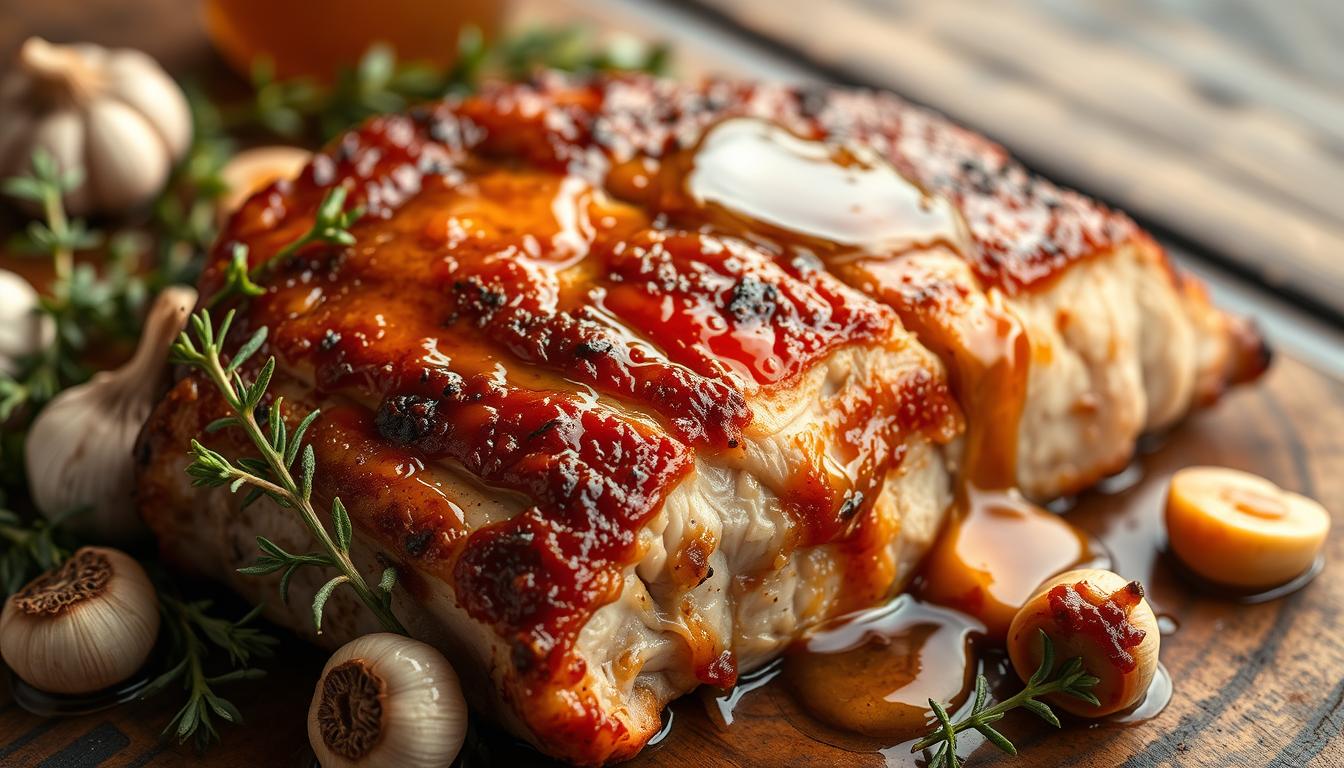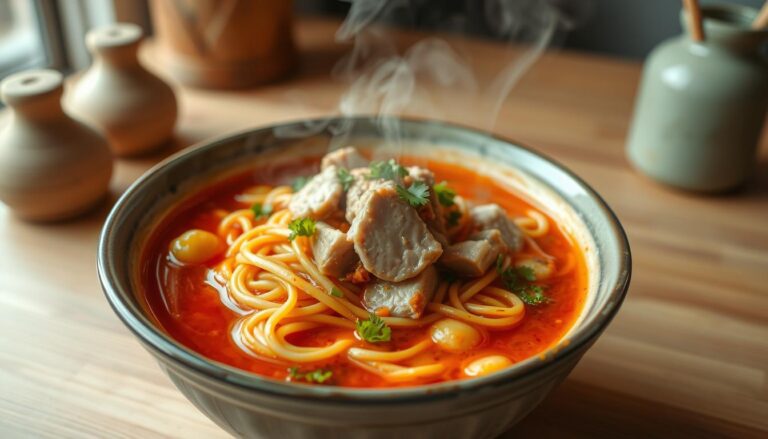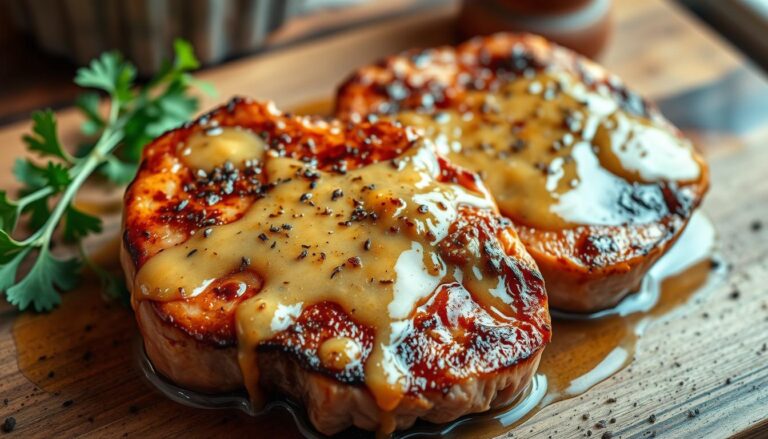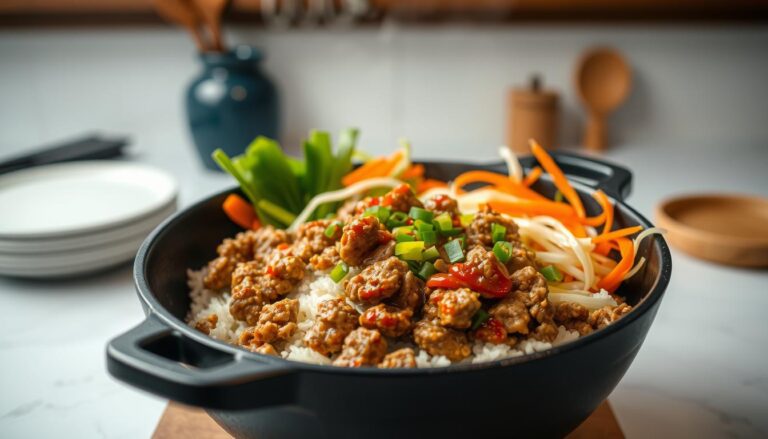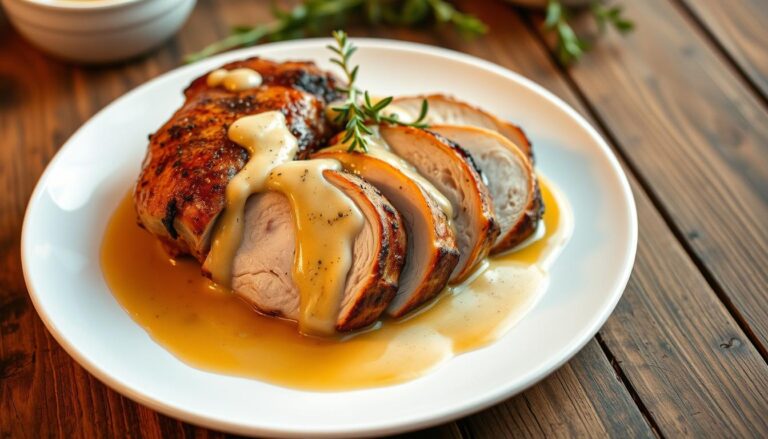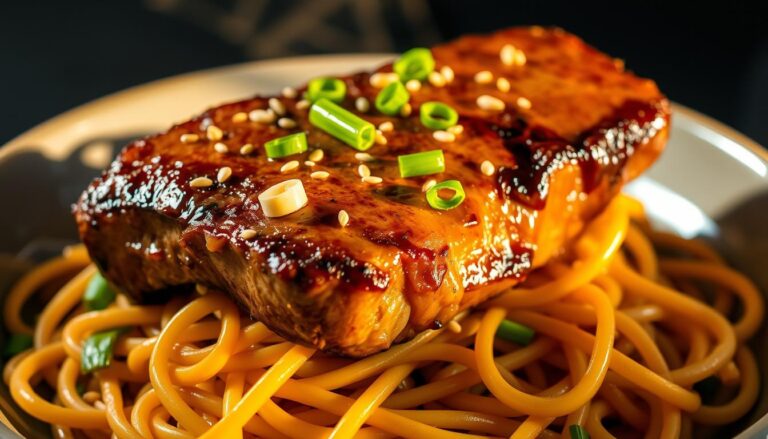Easy Roasted Honey Garlic Pork: A Tasty Meal Idea
Ever stare at the clock at 5 p.m., wondering how to make dinner feel special without the hassle? I’ve been there. Between work, chores, and life’s chaos, weeknights demand meals that are quick but never compromise on flavor. That’s why this roasted honey garlic pork recipe became my go-to.
Imagine tender pork tenderloin coated in a sticky-sweet honey garlic sauce, caramelized to perfection in just 25 minutes. The magic lies in the balance: savory garlic dances with rich honey, while a sprinkle of red pepper flakes adds subtle warmth. It’s restaurant-quality taste without the effort.
Inspired by experts like Ashley Fehr and Amanda Rettke, this dish delivers every time. Prep takes 5 minutes—just mix the sauce, pour it over the pork, and let the oven work its magic. You’ll love how the edges crisp up while the meat stays juicy inside.
This isn’t just another recipe. It’s your ticket to transforming hectic evenings into moments worth savoring. Let’s dive in.
Key Takeaways
- Whip up a flavorful honey garlic pork dinner in just 25 minutes
- 5-minute prep with pantry staples like honey, garlic, and red pepper flakes
- Oven-roasting creates caramelized edges and juicy meat
- Trusted techniques from top culinary creators
- Perfect balance of sweet, savory, and spicy flavors
- Ideal for busy weeknights or impressing last-minute guests
Overview of This Delicious Recipe
Discover how a few pantry staples can elevate pork tenderloin into a meal that’s both quick and impressive. This American-inspired dish combines lean cuts with a glossy honey garlic glaze, creating a sweet-savory balance that keeps families coming back for seconds.
What makes this recipe shine? Fresh garlic and raw honey form the sauce’s backbone, naturally tenderizing the meat while adding depth. A pinch of red pepper flakes introduces gentle heat—just enough to tingle your taste buds without overpowering the dish.
Chefs love this method because it solves two common pork problems: dryness and blandness. The oven’s high heat locks in juices while caramelizing the sauce into sticky perfection. You’ll see golden edges framing tender slices—a feast for eyes and appetite.
Though rooted in home cooking traditions, the technique borrows from professional kitchens. Rubbing the pork with spices before roasting ensures flavor penetrates every bite. Whether serving weeknight dinners or weekend guests, this recipe adapts effortlessly to your table.
Essential Ingredients and Substitutions
Your kitchen arsenal holds the secret to transforming simple pork into a caramelized masterpiece. Let’s break down what makes this dish sing—and how to adapt it when your pantry falls short.
Key Ingredients for a Flavorful Dish
Fresh garlic forms the flavor foundation—3 cloves minced deliver bold aroma without bitterness. Combine it with ¼ cup raw honey for natural sweetness that caramelizes beautifully. Soy sauce (2 tablespoons) adds umami depth, while ½ teaspoon red pepper flakes create subtle heat.
Measurements matter here: 1 teaspoon cornstarch thickens the glaze perfectly, and 1 tablespoon olive oil ensures crispy edges. Pork tenderloin works best—its lean texture absorbs flavors while staying juicy in 25 minutes of roasting.
Ingredient Variations and Substitution Tips
No soy sauce? Try coconut aminos for gluten-free savoriness. Out of fresh garlic? Use ¾ teaspoon garlic powder per clove. For a spicy kick, double the red pepper flakes or add sriracha to the glaze.
Low-sodium chicken broth can replace water if you want richer sauce. Vegetarians might swap pork for thick cauliflower steaks—roast 18-20 minutes instead. Remember: substitutions change cooking times slightly. Always check internal meat temperature with a thermometer.
Step-by-Step Preparation Guide
Transform your kitchen into a flavor lab with this foolproof method. Three crucial stages ensure golden caramelization and fork-tender meat every time.
Prepping the Pork and Seasonings
Pat the pork dry with paper towels—this helps seasoning stick better. Brush olive oil over the surface, then rub with seasoning salt and black pepper. Let it rest 5 minutes while you prep other ingredients.
Creating the Perfect Honey Garlic Sauce
Whisk these pantry heroes in a bowl:
- ¼ cup raw honey
- 3 minced garlic cloves
- 2 tbsp soy sauce
- ½ tsp red pepper flakes
Heat the mixture briefly in a saucepan until it thickens slightly. “The cornstarch activates at 140°F,” notes Ashley Fehr. “Don’t boil—just warm enough to blend flavors.”
Arranging the Cooking Process
Preheat your oven to 425°F while preparing the sauce. Place pork in a lightly oiled baking dish—don’t crowd the meat. Roast 15 minutes uncovered to develop crispy edges.
After initial cooking, brush sauce over the pork using a silicone baster. Return to oven for 8-10 minutes. This two-step method prevents the sugar in honey from burning while locking in juices.
Let meat rest 5 minutes before slicing. The internal temperature should reach 145°F for perfect doneness. Serve over rice or roasted veggies for complete weeknight dinners.
Mastering roasted-honey-garlic-pork Techniques
Cooking honey garlic pork isn’t just about mixing ingredients—it’s a science of texture and timing. Top chefs like Amanda Rettke swear by searing meat first to create a flavor-packed crust. Heat your skillet until it sizzles, then brown the pork on all sides. This step locks in juices while building caramelized edges that grip the sauce.
Your honey garlic sauce needs precision. Combine soy sauce with fresh garlic early in the process—the enzymes need time to mellow. Ashley Fehr notes, “Acidic ingredients like soy sauce tenderize meat while amplifying savory notes.” Brush half the glaze before roasting, saving the rest for basting. This layering prevents burnt sugar and ensures glossy coverage.
Timing matters most with pork chops. Their thinner cut demands shorter cook times—aim for 12-15 minutes at 400°F. Always let meat rest 5-7 minutes after roasting. Those quiet minutes let juices redistribute, transforming good pork into fork-tender perfection.
Struggling with sauce adhesion? Pat pork dry before seasoning. Moisture repels sticky glazes, while a dry surface grabs every drop. For extra insurance, mix 1 tsp cornstarch into your honey garlic sauce. It thickens the blend into a clingy coating that survives slicing.
Cooking Methods and Time Considerations
Your choice between speed and silkiness determines the pork’s final texture. High-heat roasting creates crispy edges, while slow cooking coaxes out deeper tenderness. Let’s break down how each approach affects your results.
Oven Roasting vs. Slow Cooking
Oven roasting shines when you need dinner fast. At 400°F, pork tenderloin cooks in 25 minutes—perfect for weeknights. The intense heat caramelizes honey in the sauce, creating glossy, sticky-sweet crusts. Use this method for lean cuts like chops or tenderloin.
Slow cookers transform tougher pork loin into fall-apart goodness. Braise meat on low for 6-8 hours with sauce ingredients. “Low heat breaks down collagen without drying fibers,” explains chef Carla Lalli Music. This method suits thicker cuts but requires planning ahead.
Optimizing Temperature and Timing
For oven success: preheat thoroughly. A hot oven sears the surface immediately, locking in juices. Roast pork loin (1.5-2 lbs) 20-25 minutes per pound. Always use a meat thermometer—145°F ensures safety without overcooking.
Slow-cooked dishes need liquid adjustments. Reduce sauce by ¼ when using crockpots to prevent sogginess. Stir honey into the mix during the last 30 minutes to maintain its floral notes. Pair either method with roasted veggies that cook alongside your protein.
Flavor Enhancements and Recipe Variations
Want to turn up the heat on your weeknight staple? This adaptable dish welcomes creative twists while keeping prep time under 30 minutes. Let’s explore ways to customize flavors and build memorable meals.
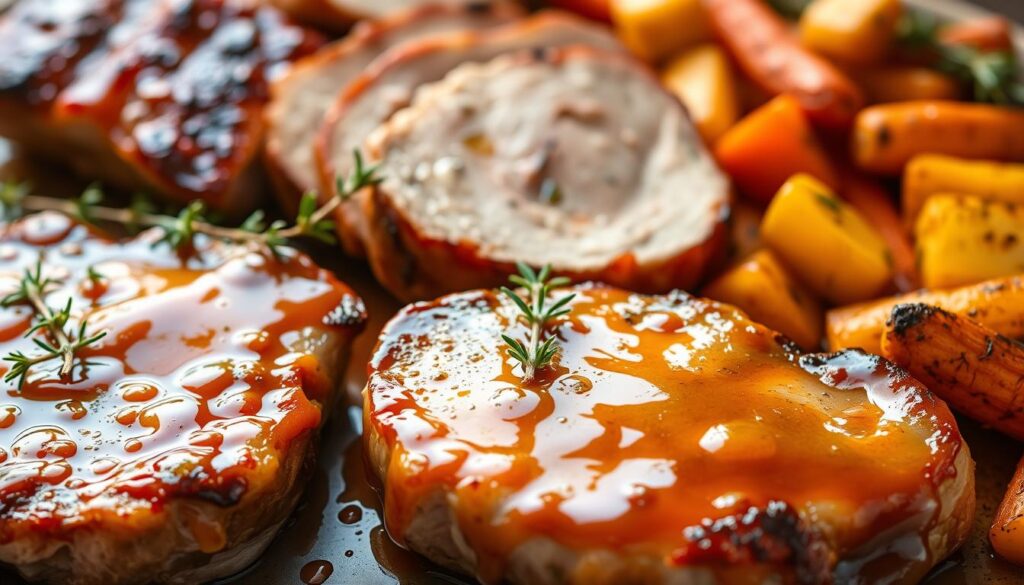
Incorporating Heat with Red Pepper Flakes
Red pepper flakes transform sweet glaze into a flavor explosion. Start with ¼ teaspoon for mild warmth or double it for fiery results. Chef Vivian Howard suggests, “Toast flakes in olive oil first to unlock smoky depth.” For bolder recipes, mix in sriracha or chili crisp during the last 5 minutes of roasting.
Complementary Sides and Garnish Ideas
Pair your pork with textures that contrast and complement. Fluffy jasmine rice absorbs sauce beautifully, while roasted broccoli adds crunch. Try these time-saving options:
- Quick-pickled carrots (5-minute prep)
- Garlic sautéed green beans
- Citrus-kissed arugula salad
Garnishes make dishes pop. Sprinkle sesame seeds for nuttiness or fresh cilantro for brightness. Swap soy sauce with tamari in the glaze for gluten-free dinners. Leftovers? Shred meat into tacos or fried rice—the flavor adapts to endless recipes.
Presentation and Plating Ideas
Did you know 70% of diners judge a dish by its appearance before tasting? Your cooking skills deserve a stage that matches their flavor. Plating transforms great meals into memorable experiences—especially when golden crusts meet vibrant garnishes.
Building Your Plate Like a Pro
Start with a hot skillet—lightly greased with oil—to reheat slices. The sizzle creates crisp edges that catch light and attention. Chef Marcus Samuelsson advises: “Contrast textures first. Crunchy pork against smooth mashed potatoes tells a story in every bite.”
Arrange meat at a 45-degree angle for depth. Drizzle thickened sauce sparingly—use the back of a spoon for artistic streaks. Sprinkle flaky salt over the pork just before serving. This enhances flavor while adding glitter-like visual appeal.
Balance colors with bright sides. Try roasted carrots with charred lemon wedges or emerald-green parsley sprigs. For portion control, slice pork into ½-inch medallions and fan them across one-third of the plate. Leave negative space to let the dish breathe.
Keep sauce pools minimal but strategic. Dip herb stems in leftover glaze and drag them across the rim for a professional touch. Your skillet isn’t just for cooking—it’s the tool that gifts that Instagram-worthy caramelized crust.
Troubleshooting Common Cooking Challenges
Even seasoned cooks face kitchen hiccups when working with lean meats. Let’s tackle common pork pitfalls and turn potential disasters into delicious victories.
Tips for Preventing Dry Meat
Temperature control makes or breaks your dish. Insert a meat thermometer into the thickest part—145°F signals perfect doneness. Chef J. Kenji López-Alt confirms: “Pork continues cooking off-heat. Remove it 5 degrees early to avoid toughness.”
Your prep routine matters. Pat meat dry before seasoning—moisture steams instead of searing. Use heavy pans like cast iron for even heat distribution. If sauce thickens too fast, add 1 tbsp water and swirl the pan gently.
Rest pork 8-10 minutes after cooking. This lets juices redistribute through the fibers. Slice too soon, and moisture floods your cutting board instead of staying in the meat.
For next-day meals, store leftovers in airtight containers. Reheat slices in a skillet with ¼ cup broth to revive tenderness. Adjust oven racks to center position—hot spots cause uneven cooking. Keep these strategies on your mental table for juicy results every time.
Conclusion
Weeknight dinners just got a flavor upgrade that’s as smart as it is delicious. This recipe transforms basic ingredients into juicy pork with minimal effort. Whether using quick-cooking tenderloin or thicker pork loin, the key lies in timing and technique.
Medium-high heat (425°F) creates caramelized edges while keeping meat tender. A teaspoon of red pepper flakes adds subtle warmth—adjust it to match your spice tolerance. Always let the pork rest before slicing to preserve those precious juices.
Pour sauce in two stages: brush half during roasting for sticky glaze, then drizzle the rest after slicing. This method ensures every bite bursts with sweet-garlic harmony. Pair with rice or veggies for balanced meals that feel special.
Ready to impress your table? Tag your creations using #HoneyGarlicMagic—we’d love to see how you make this dish yours. With these tips, even hectic nights can taste like weekend feasts.
FAQ
Can I substitute soy sauce in the honey garlic sauce?
Yes! For a gluten-free option, use Tamari or coconut aminos. Both alternatives maintain the savory depth while adjusting to dietary needs.
How do I prevent the pork from drying out during roasting?
Brine the pork in saltwater for 30 minutes before cooking. Always let the meat rest for 5–7 minutes after roasting to lock in juices.
Can I use pork chops instead of pork loin for this recipe?
Absolutely. Adjust cooking time to 20–25 minutes at 375°F (190°C) since chops are thinner. Use a meat thermometer to ensure they reach 145°F (63°C).
How spicy does the red pepper flakes make the dish?
A ½ teaspoon adds mild heat. For more kick, increase to 1 teaspoon or add a dash of sriracha to the honey garlic sauce.
What sides pair well with honey garlic pork?
Serve with roasted vegetables, jasmine rice, or garlic mashed potatoes. A crisp green salad balances the dish’s richness.
Can I prepare the sauce ahead of time?
Yes! Store the honey garlic sauce in an airtight container for up to 3 days. Reheat gently before brushing onto the pork.
Is slow cooking an option for this recipe?
Definitely. Cook on low for 6–7 hours. Add the sauce during the last 30 minutes to prevent burning.
How do I know when the pork is fully cooked?
Use a meat thermometer. The internal temperature should reach 145°F (63°C). The meat will be slightly pink but safe to eat.
Can I reduce the sweetness of the honey garlic sauce?
Yes. Replace half the honey with low-sodium chicken broth or apple cider vinegar for a tangier, less sweet flavor profile.
How long do leftovers last in the fridge?
Store leftovers in an airtight container for up to 4 days. Reheat in the oven at 325°F (163°C) to retain texture.

